This was published 6 years ago
Chichicastenango Guatemala: Put on a brave face at the market
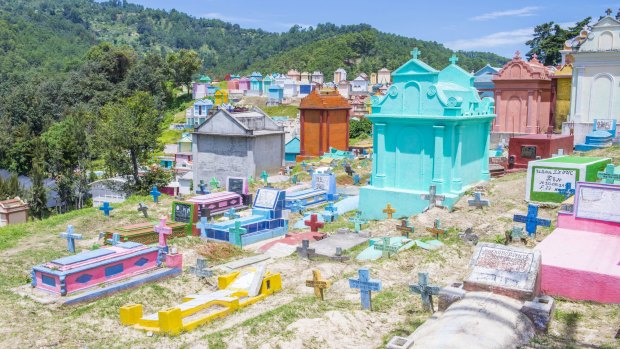
In Guatemala, family members paint the tombstone as a way of honoring the dead.Credit: Shutterstock
As someone with an almost phobic aversion to shopping, the thought of visiting one of Central America's largest and busiest markets fills me with stomach-curdling dread. Every Thursday and Sunday the town of Chichicastenango (known as Chichi) in the highlands of central Guatemala erupts into a riot of colour and commerce. Stalls selling everything from handicrafts to phones to kittens line its narrow cobbled streets, attracting both locals (many of whom trek for hours carrying their wares over mountainous terrain) and tourists, who turn up by the bus load. It sounds like my worst nightmare – a giant jostley, hassley hell.
My guide, Julio, however, is undeterred. He assures me that Chichi has many other appealing features. Unfortunately, we've arrived on a Thursday so in order to reach them we'll have to battle our way through the market. Adopting my best "I'm not here to shop" face, I take a deep breath and we enter the fray.
Our first port of call is the Church of St Thomas, an elegant 16th-century whitewashed church near the town centre that was built on the site of a pre-Columbian temple. Most of Chichi's population (and that of the surrounding towns) is indigenous Maya K'iche, who still speak the K'iche language and follow the Maya religion. When the Spanish invaded in 1524, they introduced Catholicism and today the two religions coexist in a bizarre but fascinating harmony.
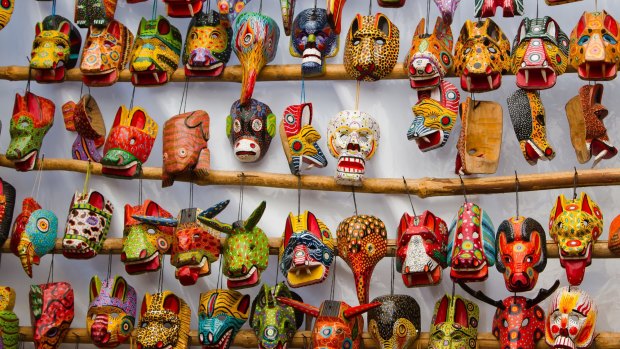
Mayan wooden masks for sale in Chichicastenango.Credit: Shutterstock
Leading up to the church are 18 steps, one for each month of the Maya calendar, and near the entrance is a stone altar where local shamans perform rituals and sacrifices. Christian paintings and sculptures decorate the church's interior while the central aisle contains six additional Maya stone altars.
We watch a local indigenous couple – both immaculately dressed in brightly-coloured traditional clothing – shuffle on their knees up the aisle while chanting softly. When they reach the first altar, they light two candles, make offerings of flowers and rum, then bow down in prayer. It's a captivating spectacle, made all the more intriguing given it takes place under the watchful gaze of a row of Christian saints.
Our next stop further demonstrates this curious religious intermingling. The town's cemetery contains hundreds of graves, ranging from simple plots marked with a single cross to elaborate tombs containing several generations. Many of the tombs feature ornate decorative flourishes, such as columns and wrought iron gates, and are painted in colourful pastel hues. It's certainly a far cry from the dour, sombre mood of a European graveyard. Julio explains that during the annual Day of the Dead festival in November, the cemetery takes on a carnival-like atmosphere. Families pay their respects by feasting, dancing and decorating their loved ones' tombs.
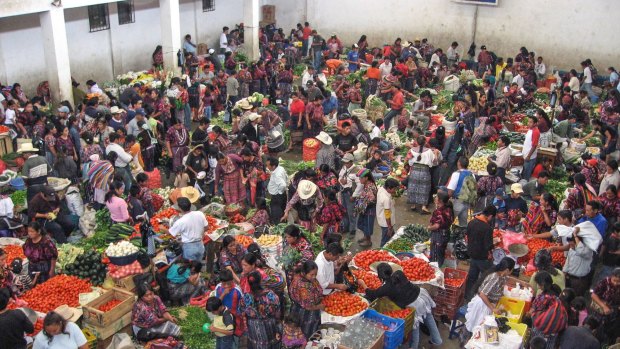
The busy produce market in draws buyers and sellers within the local area each Thursday and Sunday.Credit: Shutterstock
As we near the centre of the cemetery, Julio points out a simple open-sided brick shelter in which a shaman is preparing to perform a traditional Maya ceremony. After spitting alcohol over a stone altar, he'll light a small fire, which he'll then "read" in order to offer guidance and advice. In the case where a person needs to be purged of bad spirits, he'll spit alcohol over them and then hit them repeatedly with a sacred plant.
Our last stop is a workshop where they make the masks and costumes for Chichi's annual Festival of St Thomas. During this colourful celebration in December, a marimba band and a large crowd of fancifully dressed locals parade through the town, dancing and drinking. The costumes are exaggerated versions of those worn by the invading Spanish – all bright velvet, sequins and tassels – while the masks have blond beards and bright blue eyes.
I try one on and am astonished at how heavy it is. The elaborate headgear, with its colourful plumes and intricate beading, must weigh at least two kilograms. With only two small eye holes to see through, the wooden mask feels uncomfortably claustrophobic. Drinking and dancing all day dressed up in this garb would require serious stamina.
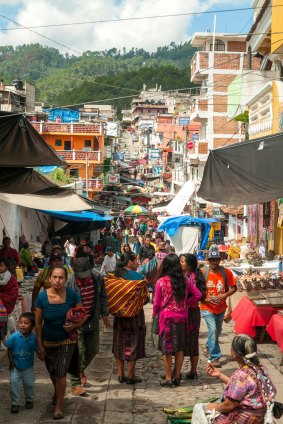
The market at Chichicastenango offers an immersive insight into Guatemala's indigenous culture.Credit: Alamy
To reach lunch we have to navigate the market again, but this time we pass through the permanent central part, which operates daily and is frequented by locals, rather than the outer ring which caters more for tourists. We weave through a maze of stalls, past piles of fresh vegetables, large sacks of corn maize and slippery piles of raw chicken. Julio explains that indigenous Maya from all over the region congregate here to shop, socialise and share news. It's also where many couples meet and lots of the young women are beautifully dressed in brightly-coloured hand-woven skirts and tops. Families noisily crowd around wooden tables to eat tortillas and fried chicken, while children squeal and chase each other through the warren of narrow alleyways.
All in all, it's an immersive insight into Guatemala's indigenous culture. Not once do I get jostled or hassled and at one point I even get an urge to stop and browse (don't worry, I fight it). Don't tell anyone, but it's the closest I've come to enjoying myself at a market yet.
Rob McFarland was a guest of Air New Zealand and Chimu Adventures.
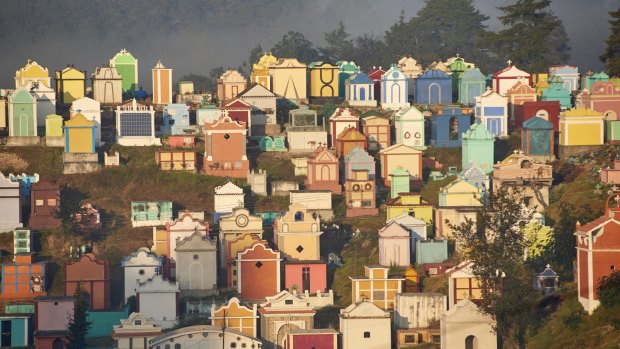
The famous Chichicastenango cemetery.Credit: Shutterstock
TRIP NOTES
MORE
FLY
Air New Zealand flies via Auckland to Houston with onward connections to Guatemala City. Chichicastenango is 130 kilometres north-west of Guatemala City. See airnewzealand.com.au; united.com
TOUR
Latin America specialist Chimu Adventures can create a tailor-made Guatemala itinerary including flights, accommodation, transfers and tours. Phone 1300 773 231; see chimuadventures.com
Sign up for the Traveller Deals newsletter
Get exclusive travel deals delivered straight to your inbox. Sign up now.